Jigsaw puzzles from Japan
Shrines and temples
On this page: Puzzles - "What's the difference between a temple and a shrine?"
Puzzles
2016 pieces
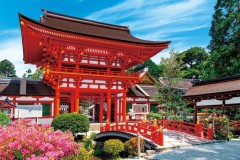 © Epoch 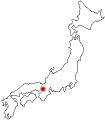
2016: Kamigamo Shrine, KyotoThis is one of two associated Shinto shrines on the Kamo river in northern Kyoto, its name meaning "Upper Kamo shrine" — the other is Shimogamo ("Lower Kamo"). The two have a very long history, going back to the Heian period (c. AD 800), but as is the tradition the structures themselves are maintained and rebuilt as necessary. This is the immensely ornate main gate (rōmon). One of the oldest shrines in Japan, it is now a World Heritage site.
 In stock In stockAn Epoch puzzle: 2016 pieces; 750 x 500 mm (30" x 20") Code: E22108 (22-108 on package) Retail price ¥2800 (approx. US$19.31 €17.83 £14.97) All about ordering (please read first)
|
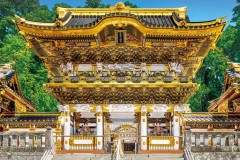 © Ogawa Hidekazu 
2016: Yōmeimon at NikkoThis spectacular entrance gateway, Yōmeimon, is the central feature of the Nikkō World Heritage site. The whole site is a Shinto shrine (Tōshōgu) built in the early 1600s to honour Tokugawa Ieyasu, the very first Shogun of the Tokugawa era. Since he was the most powerful man in Japan at the time, perhaps it is not so surprising that for a Shinto building this is unusually ornate.
 In stock In stockAn Epoch puzzle: 2016 pieces; 750 x 500 mm (30" x 20") Code: E22106 (22-106 on package) Retail price ¥2800 (approx. US$19.31 €17.83 £14.97) All about ordering (please read first)
|
2000 pieces
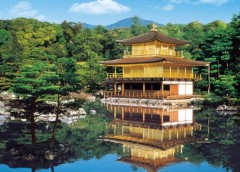 © Epoch 
2000: Kinkaku-jiPerhaps the most famous of Kyoto's temples, this is the "Gold pavilion." It was originally built in the 1300s, and given to the Shogun Ashikaga Yoshimitsu in 1397, but was destroyed in an arson attack in 1950. Rebuilt in 1955, the gold leaf covering was only completely restored in 1987. Like the "Silver pavilion," this is only a nickname, and the formal temple name is Rokuonji.
 In stock In stockAn Epoch puzzle: 2000 pieces; 530 x 380 mm (21" x 15") Code: E54001 (54-001 on package) Retail price ¥2000 (approx. US$13.79 €12.74 £10.70) All about ordering (please read first)
|
1053 pieces
 © Epoch 
1053: Shimogamo shrineThe entrance to this Kyoto shrine, from the ceremonial torii on the left, over a small bridge in traditional style, leading to the main gate building.
 In stock In stockAn Epoch puzzle: 1053 pieces; 380 x 260 mm (15" x 10") Code: E31014 (31-014 on package) Retail price ¥1600 (approx. US$11.03 €10.19 £8.56) All about ordering (please read first)
|
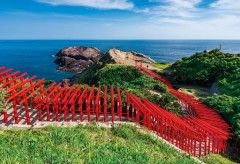 © Epoch 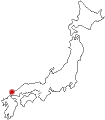
1053: Moto-no-sumi shrineWalk around any town, and sooner or later you will see a torii, the ceremonial gateway (a frame with two horizontal bars), indicating the entrance to a Shinto shrine not too far away. Sometimes there will be a sequence of two or three. But this shrine on the Yamaguchi coast in western Japan takes things to a new level: 123 torii lead from the rocks on the shore up to the shrine itself (behind us in the picture).
 In stock In stockAn Epoch puzzle: 1053 pieces; 380 x 260 mm (15" x 10") Code: E31019 (31-019 on package) Retail price ¥1600 (approx. US$11.03 €10.19 £8.56) All about ordering (please read first)
|
1000 pieces
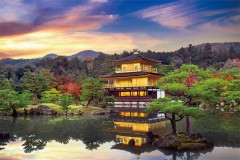 © Yanoman 
1000: KinkakujiA dramatic view of perhaps the most famous of Kyoto's temples, the "Gold pavilion." It was originally built in the 1300s, and given to the Shogun Ashikaga Yoshimitsu in 1397, but was destroyed in an arson attack in 1950. Rebuilt in 1955, the gold leaf covering was only completely restored in 1987. Like the "Silver pavilion," this is only a nickname, and the formal temple name is Rokuonji. What does the name mean?
 In stock In stockA Yanoman puzzle: 1000 pieces; 750 x 500 mm (30" x 20") Code: Y101315 (10-1315 on package) Retail price ¥2700 (approx. US$18.62 €17.20 £14.44) All about ordering (please read first)
| |||
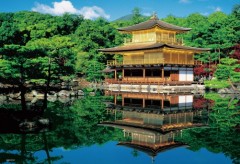 © Beverly 
1000: KinkakujiPerhaps the most famous of Kyoto's temples, this is the "Gold pavilion." It was originally built in the 1300s, and given to the Shogun Ashikaga Yoshimitsu in 1397, but was destroyed in an arson attack in 1950. Rebuilt in 1955, the gold leaf covering was only completely restored in 1987. Actually, "Gold pavilion" is only a nickname, and the formal temple name is Rokuonji. What does the name mean?
 In stock In stockA Beverly puzzle: 1000 pieces; 380 x 260 mm (15" x 10") Code: BM81835 (M81-835 on package) Retail price ¥2000 (approx. US$13.79 €12.74 £10.70) All about ordering (please read first)
| |||
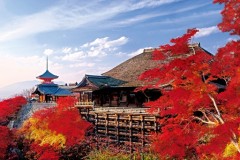 © Aflo 
1000: Kiyomizu autumn coloursThis very famous temple is trestled out from the side of the hill overlooking Kyoto. The original temple is said to have been founded more than 1200 years ago, but most of the present structure dates from the 1600s.  In stock In stockAn Epoch puzzle: 1000 pieces; 750 x 500 mm (30" x 20") Code: E10786 (10-786 on package) Retail price ¥2500 (approx. US$17.24 €15.92 £13.37) All about ordering (please read first)
| |||
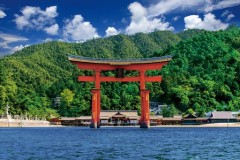 © JTB Photo 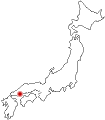
1000: Itsukushima shrineRegistered since 1996 as a UNESCO World Heritage site, and famous as one of the traditional "Three sights of Japan", this is the great torii, or Shinto ceremonial gateway of Itsukushima shrine, submerged by the tide. This is actually a very unusual view, looking in from the sea, and emphasising the massive scale of the structure.  In stock In stockAn Epoch puzzle: 1000 pieces; 750 x 500 mm (30" x 20") Code: E10776 (10-776 on package) Retail price ¥2500 (approx. US$17.24 €15.92 £13.37) All about ordering (please read first)
| |||
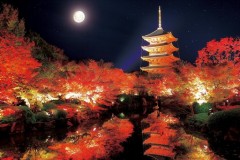 © Epoch 
1000: Autumn pagoda by moonlightA dramatic moonlit view of the garden of the Kyoto temple of Tō-ji, showing the historic pagoda which is the tallest wooden building in Japan.  In stock In stockAn Epoch puzzle: 1000 pieces; 750 x 500 mm (30" x 20") Code: E10802 (10-802 on package) Retail price ¥2500 (approx. US$17.24 €15.92 £13.37) All about ordering (please read first)
| |||
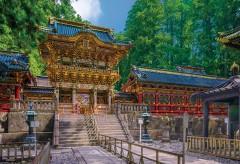 © Beverly 
1000: Tōshōgu, NikkoThis spectacular entrance, Yōmeimon, is the central feature of this World Heritage site in Nikkō (Tochigi). The whole site is a Shinto shrine (Tōshōgu) built in the early 1600s to honour Tokugawa Ieyasu, the very first Shogun of the Tokugawa era. Since he was the most powerful man in Japan at the time, perhaps it is not so surprising that for a Shinto building this is unusually ornate.
 In stock In stockA Beverly puzzle: 1000 pieces; 380 x 260 mm (15" x 10") Code: BM81856 (M81-856 on package) Retail price ¥2000 (approx. US$13.79 €12.74 £10.70) All about ordering (please read first)
| |||
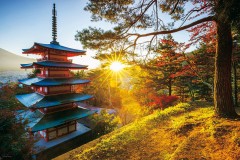 © Yanoman 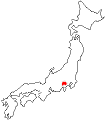
1000: Sunrise on pagodaA pagoda in the morning sun... somewhere in Yamanashi.  In stock In stockA Yanoman puzzle: 1000 pieces; 750 x 500 mm (30" x 20") Code: Y101326 (10-1326 on package) Retail price ¥2500 (approx. US$17.24 €15.92 £13.37) All about ordering (please read first)
| |||
 © Beverly 
1000: Byōdōin, KyotoA night view of one of the most famous temples in Kyoto: the reflection makes for an interesting puzzle. The building, which appears in the design on a 10-yen coin in this view, is the Amida Hall, or more familiarly the Phoenix Hall, after the birds perched on top of the central roof. Mark Schumacher has an interesting page on the phoenix, including closeups of the birds on roof of this temple.
 In stock In stockA Beverly puzzle: 1000 pieces; 380 x 260 mm (15" x 10") Code: BM81572 (M81-572 on package) Retail price ¥2200 (approx. US$15.17 €14.01 £11.76) All about ordering (please read first)
| |||
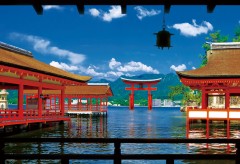 © Beverly 
1000: Itsukushima shrineThe classic view of the Itsukushima shrine, looking out into the bay at the great torii. This Shinto ceremonial gateway was completed in 1875, and is unusual in being sited in the tidal part of the bay. This is famous as one of the traditional "Three sights of Japan" - and since 1996 has been registered as a UNESCO World Heritage site.
 In stock In stockA Beverly puzzle: 1000 pieces; 380 x 260 mm (15" x 10") Code: BM81596 (M81-596 on package) Retail price ¥2200 (approx. US$15.17 €14.01 £11.76) All about ordering (please read first)
| |||
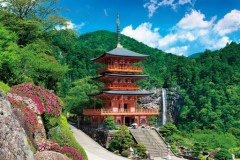 © Aflo 
1000: Seiganto temple and Nachi fallsNear the southern tip of the Kii peninsula below Kyoto, this pagoda, just part of the temple complex, enjoys a commanding view of the impressive Nachi falls. Although the falls are actually across a valley, a suitable viewpoint brings them into the same picture.  In stock In stockAn Epoch puzzle: 1000 pieces; 750 x 500 mm (30" x 20") Code: E10781 (10-781 on package) Retail price ¥2500 (approx. US$17.24 €15.92 £13.37) All about ordering (please read first)
|
"What's the difference between a temple and a shrine?"
Regardless of their connotations in English, according to a convention of Japanology these words are used to distinguish buildings of the separate religious traditions of Buddhism and Shinto.
| Japanese characters | Meaning | Map symbol | |
|---|---|---|---|
| "Temple" |  |
A Buddhist temple: these are usually (but not necessarily) imposing structures. The character shown on the left appears at the end of the temple name, and can be read "-ji" (the Chinese reading) or "-tera/-dera" (the native Japanese reading). The map symbol used for a Buddhist temple is the ancient swastika (not the reversed swastika appropriated by the Nazis). |  |
| "Shrine" |  |
A Shinto shrine: these can be anything from a tiny shack perched on a rock in the sea to an imposing building (that we would naturally call a temple). In Japanese the word used is usually jinja, as shown on the left, though the most important buildings are called taisha, or "Grand Shrine". The map symbol used for a Shinto shrine is a torii, the ceremonial gateway, usually of wood or stone, that marks the approach. |  |
Deleted puzzles
For reference: you can view all the puzzles from this page that are now out of print in the Attic.

 This puzzle has smaller pieces than the standard size.
This puzzle has smaller pieces than the standard size.